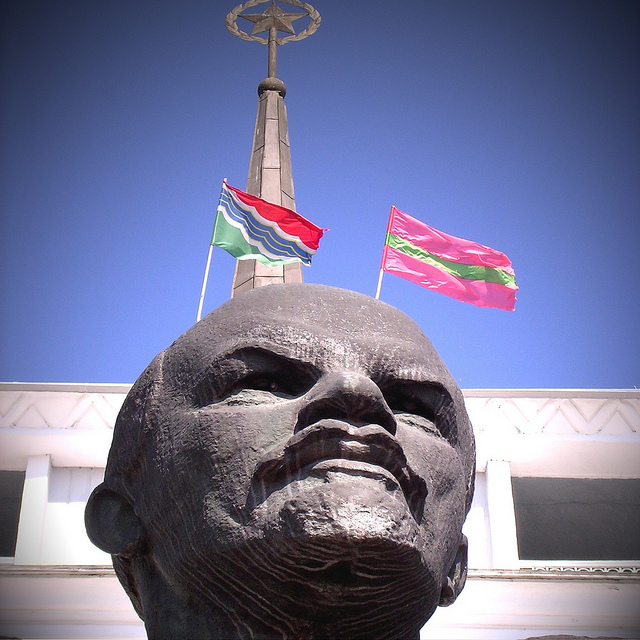
By: William Robinson
Ukraine is not the only target of Russian expansion – it was not even the first. In fact, several countries along Russia’s border possess a sizable population of ethnic Russians. These ethnic Russians form homogenous pockets in their respective countries, and their regions have become targets for Russia’s nationalistic policy. Crimea is the most obvious example of these regions, which together constitute Russia’s Near Abroad. Although Ukraine has taken the spotlight concerning the Near Abroad, Russia has been actively working to re-exert control over several Near Abroad regions in various countries since the early 1990’s, especially Moldova and Georgia. Their successful annexation of Crimea and intervention in Eastern Ukraine, however, creates new possibilities for Russia’s takeovers in the Near Abroad.
Russian policy has been structured to consider three kinds of people since the fall of the Soviet Union in 1991: Russians in Russia, Russians outside of Russia, and everyone else. The Russians outside of Russia are members of the Near Abroad and have always been a fixation of Russia’s foreign policy. In 1992 one of President Boris Yeltsin’s advisors, Sergei Karaganov, defined Russian policy toward the Near Abroad as justifiable Russian intervention into the former Soviet Union for the protection of Russian compatriots abroad. This line of reasoning, now called the Karaganov Doctrine, is exactly how current President Vladimir Putin defended Russian intervention in Ukraine. Long before Putin, however, Moldova and Georgia felt the effects of the Karaganov Doctrine, even while Yeltsin still presided over Russia.
In 1991, Moldova won its independence from the Soviet Union, but it immediately faced a pro-Soviet secessionist movement. The secessionist region was Transnistria, and it housed Moldova’s former Soviet bureaucracy and much of the Soviet 14th Army. That army division was supposed to leave Moldova in 1991, just as Soviet divisions had left the other newly independent states of the former Soviet Union, but in Transnistria, they stayed. They stayed, and they fought. The intervention of the Russian troops saved the secessionist movement in Moldova, keeping the Moldovan government from taking the region or policing it. Ten years later, the Russian troops were still there – within the supposedly sovereign nation of Moldova. During a session in 2001, a Moldovan ambassador addressed the U.S. Congress, which was discussing the progress of an agreement wherein Russia had finally agreed to withdraw its troops from Transnistria. The ambassador described what the region had become:
“The separatists turned [Transnistria] into a territory out of any control, into a land of illegal trafficking of human beings, alcohol, tobacco, drugs, and firearms: anti-tank weapons, mortars, and rocket launchers, manufactured in [Transnistria] and illegally marketed to hot spots in the former Soviet Union like Chechnya, the Baltics, rogue countries like Iran and Iraq, and falling into the hands of various terrorist groups.”
Due to the decade-long presence of Russian troops in a pro-Soviet region, Russia subverted the sovereignty of a neighboring country and established a pseudo-state within a state, a region outside of the control of its recognized government.
Georgia similarly has faced secessionist movements from two regions throughout its 23 year post-Soviet history, the regions of South Ossetia and Abkhazia. The regions are situated in northern Georgia along the Russian border. In 2009, Russia invaded Georgia under the guise of defending the self-determinist rights of the two regions who were under the boot of a repressive regime – not unlike Putin’s claims concerning the people of Crimea and Donetsk. “The response,” according to U.S. Army War College professor Stephen Blank, “was one of rhetoric over action, disorientation rather than policy coherence, internal division and allied disunity rather than Western solidarity, and drift rather than resolution.” In short, there was not a response – except from Ukraine, which came under immediate economic and political attack from Russia.
In Georgia, invasion succeeded in accomplishing all of Russia’s goals: NATO and EU both withdrew support for incorporating Georgia; Abkhazia and South Ossetia are largely out of the control of Georgia – undermining Georgia’s strength and sovereignty; and these regions are completely loyal to Russia. Since withdrawing its troops, Russia has recognized the independence of the regions (the only country to do so), staffed much of the bureaucracy of the regions’ de facto governments, made the ruble the official currency of the regions, provided millions of dollars of aid and investment, and provided full scholarships to Abkhazians and Ossetians for universities in Russia. Through an eased process of obtaining Russian citizenship, most of the regions’ non-ethnic-Georgian citizens have claimed Russian citizenship. That means there are Russian “citizens” receiving Russian aid, doing business in rubles, speaking predominantly Russian, looking to native Russians as their legitimate government, and attending Russian universities while living in Georgia and being perceived internationally as solely Georgian citizens.
Flushing out the recent history of Russia’s intervention in the Near Abroad, it is clear that Ukraine is not an anomaly. It is a part of the Karaganov Doctrine, just as Georgia and Moldova were. Furthermore, there are several other regions constituting the Near Abroad in which Russia has not actively intervened yet. Many of these regions are in NATO countries, such as the Baltic countries. This has several implications for U.S. foreign policy.
First, American policymakers must accept that Russia’s actions in Ukraine are not isolated. They are part of a sustained policy of reclaiming the Near Abroad. This policy has been in place since the Soviet Union collapsed, and there is considerable nationalistic support in Russia to reclaim the Near Abroad. Second, NATO needs to become a bigger priority in defense policy-making. This has to happen despite the fact that ISIL keeps policymakers busy in the Middle East and as the military continues its “shift to the Pacific.” Russia’s offensive behavior demands a defensive counter, and a counter to expansion is NATO’s reason for being. The near future of the Near Abroad will be one of Russian expansion and NATO deterrence. The amount of expansion will depend on the effectiveness of NATO’s deterrence.

